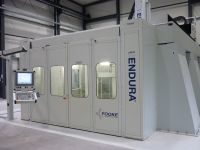Fooke Offers Five-Axis Milling Machines

In the past, various lateral or travelling column milling machines were used for building models and prototypes. Today, the use of Fooke portal milling machines from the Endura 600Linear and Endura 900Linear ranges is on the rise. A standard 1:1 portal milling machine from the Endura900Linear range has traverse paths of 7,500 x 3,500 x 2,500 mm. This allows all standard car models to be processed on a 1:1 scale. "When it comes right down to it, the machine's construction is extremely simple", states Christian Spieker, head of technical development at Fooke. "Even on such large machines, it takes an optimum balance between structural rigidity and mass, along with the use of linear drive motors in all linear and torque motors on the rotary axes, to ensure maximum dynamism, i.e. acceleration and jerk."
Fooke supplies Endura machines with the leading CNC controls on the market. Surpassing the standards already achieved by excellent controls, Fooke Endura machines also feature special "Fooke dynamic parameter sets". The programmer/machine operator can select different dynamic parameter sets according to the processing task and the required surface quality and accuracy. Fooke's dynamic parameter sets directly influence the dynamic values set in the PLC, such as speed, acceleration and jerk.
The milling unit-a high-frequency milling spindle-is installed in a highly accurate 2-axis milling head. As a rule, Fooke equips all of its milling machines for building models and prototypes with the HSK63 Form A tool interface. Although milling process forces are fairly manageable when handling industrial clay, model board and even aluminium, this relatively large tool interface still makes sense, as, time and again, long tools - 400 mm and sometimes even longer - are used to reliably access deep cavities or areas which are difficult to reach while still delivering excellent cutting rates. This type of machine's basic equipment includes an automatic tool changer, workpiece and tool measurement technology, a tarpaulin, and an extraction and chip conveying system.
"Special attention is paid to dust and chips. Customers often have different priorities in this area. If a customer tends to process more model boards, suction plays a major role. On the other hand, styling clay cannot be extracted by suction. There is also the fact that some customers may wish to use the machine to process aluminium. There are relatively few standards here. Fooke has always been able to come up with solutions", says Andreas Feldevert, Head of Endura Milling Machines and System Solutions for Central Europe. "We can satisfy virtually any customer request. For example, an "electromechanical lifting device for design models" was developed and integrated into the machine table or clamping plate. Thanks to this lifting device, the design model being processed can be precisely lifted and attached so that areas which are difficult to reach (e.g. sillboards or wheel housing) can be processed more efficiently and accurately."
Fooke is set to deliver two Endura 904Linear machines. Both machines have traverse paths of 7,500 x 4,000 x 3,000 mm. And these machines are not limited to manufacturing 1:1 scale models of cars. In the future, it will also be possible to process transport and utility vehicle models using these machines.





